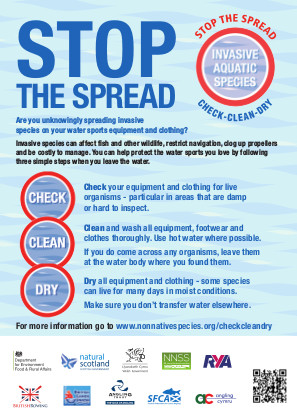We have received the following email from the Environment Agency, and have been asked to publicise this issue. In addition to the email below the Environment Agency have prepared a poster (download through this link) that landowners are asked to display where the public access property by watercourses, and local community groups should display on their websites.

The Environment Agency is investigating the deaths of our rare protected native white clawed Crayfish in three locations across the Severn and Wye river catchment. We expect this to be confirmed as Crayfish Plague which is very infectious for Crayfish.
We are contacting you to help us limit the risk of future deaths of this endangered species by taking simple biosecurity steps.
White clawed Crayfish look like miniature lobsters, they hide away under rocks and logs during the day, and emerge during the night to eat. They are our largest freshwater invertebrate and the few remaining populations are very vulnerable to this disease and face local extinction. Crayfish Plague is a species specific disease and has no implications for human or other animal health.
Dead white clawed Crayfish have been seen in the following catchments: Nailsworth Stream, Gloucestershire Dowles Brook, Wyre Forest The River Redlake, Shropshire
White Clawed Crayfish maybe infected, but apparently healthy, and continue to die for several weeks in these locations therefore an outbreak of Crayfish Plague can last for several weeks. The disease can be transferred to White Clawed Crayfish via water and mud on damp clothes, footwear, bike tyres, fishing or boating equipment or any machinery. The Crayfish Plague pathogens can live for 22 days on damp clothes or equipment.
We are asking the public to stay out of watercourses in these areas. If you are using equipment in any river, to stop the spread of the Plague, other infectious diseases or invasive species, please follow these steps:
- Clean off any mud or vegetation and remove any standing water.
- Either thoroughly dry the equipment, preferably in sunlight making sure all nooks and crannies are dry OR Treat with a disinfectant capable of killing fungal spores.
- If you or your dog goes into a stream, do not go into another stream on the same day.
Please find attached posters about the white clawed Crayfish deaths and what your organisation and communities can do to potentially stop this spreading to other watercourses. Please can you circulate this email and advice to your networks and workforce, print and put up these posters on your notice boards and where the public access water courses on your property? We will be putting copies of these posters on community notice boards close to watercourses. If you would like additional information about increasing your biosecurity and targeting other vulnerable White Claw Crayfish populations you can contact us at
We have temporarily suspended Environment Agency routine activities in these watercourses and are taking additional precautions in other catchments with native crayfish.
If you see dead Crayfish or an environmental incident please phone 0800 80 70 60.
Please do not handle or remove live or dead Crayfish. It is illegal to do this without a license.
Thank you for your support and increased biosecurity to limit the deaths of the rare native crayfish.
Yours faithfully
Malcolm Lythgo
Incident Area Base Controller
Environment Agency
Shropshire, Herefordshire, Worcestershire and Gloucestershire (SHWG) – Part of the West Midland Area

